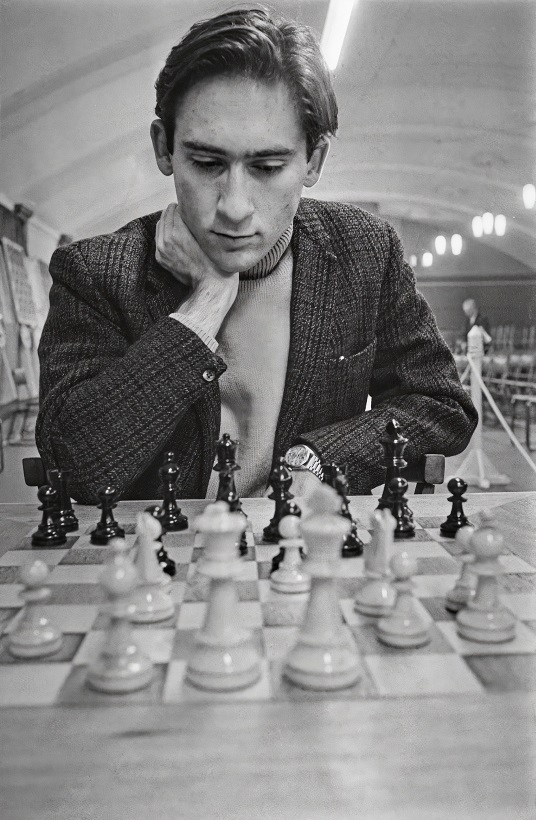
Edward Winter

William Roland Hartston in February 1973 (Hulton Archive)
Since writing earlier about the preponderance of books on chess openings to the detriment of other aspects of the game’s literature, we have seen the issue put very fairly by Bill Hartston in the 31 October-6 November 1980 issue of the now defunct magazine Now! (page 88):
‘... as any publisher knows, the only chess books which can guarantee to sell well are either beginners’ manuals or opening theory. The middlegame, surely the most interesting and varied part of chess, somehow does not seem to appeal to the purchaser. Perhaps the wealth of ideas involved makes the middlegame too difficult to cover adequately; certainly it is the hardest part of the game to study. Though opening theory offers the reader precise moves in positions he is likely to reach shortly after the start of a game, all a writer can offer for middlegame advice is a bewildering complex of tactical and strategic ideas to which the reader can attach no immediate relevance. Most players, however, would profit far more by spending their time on acquiring middlegame understanding, rather than learning opening variations.’
(201)
In 1985 Leonard Barden (London) kindly sent us the original game-scores from a simultaneous exhibition by Tal at John Lewis’s, Oxford Street, London in 1964 (+12 =8 –4). At the time we published only one of them (in C.N. 1000, Tal v E.W. Jaggs – see page 53 of Kings, Commoners and Knaves), but our feature article Mikhail Tal in London (1964) includes almost the complete set. One of the score-sheets:
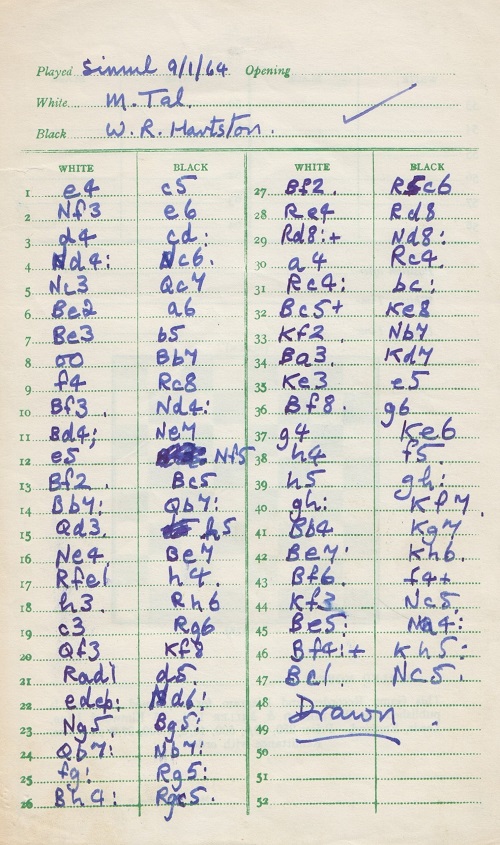
Mikhail Tal – William Roland Hartston
London, 9 January 1964
Sicilian Defence
1 e4 c5 2 Nf3 e6 3 d4 cxd4 4 Nxd4 Nc6 5 Nc3 Qc7 6 Be2 a6 7 Be3 b5 8 O-O Bb7 9 f4 Rc8 10 Bf3 Nxd4 11 Bxd4 Ne7 12 e5 Nf5 13 Bf2 Bc5 14 Bxb7 Qxb7 15 Qd3 h5 16 Ne4 Be7 17 Rfe1 h4 18 h3 Rh6 19 c3 Rg6 20 Qf3 Kf8 21 Rad1 d5 22 exd6 Nxd6 23 Ng5 Bxg5 24 Qxb7 Nxb7 25 fxg5 Rxg5 26 Bxh4 Rgc5 27 Bf2 R5c6 28 Re4 Rd8 29 Rxd8+ Nxd8 30 a4 Rc4 31 Rxc4 bxc4 32 Bc5+ Ke8 33 Kf2 Nb7 34 Ba3 Kd7 35 Ke3 e5 36 Bf8 g6 37 g4 Ke6 38 h4 f5 39 h5 gxh5 40 gxh5 Kf7 41 Bb4 Kg7 42 Be7 Kh6 43 Bf6 f4+ 44 Kf3 Nc5 45 Bxe5 Nxa4 46 Bxf4+ Kxh5 47 Bc1 Nc5 Drawn.
Below is the heading of a report about a chess-billiards contest supposedly involving Capablanca in the October 1982 issue of the Yugoslav magazine Šahovski Glasnik (pages 363-364), first referred to in C.N. 318 and subsequently shown to be a hoax:
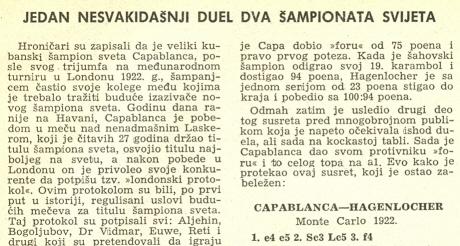
W.R. Hartston (Cambridge, England) sends the following:
‘There’s an interesting postscript to your Nos. 318 and 368 which makes it all the sadder that the story wasn’t authentic. During the Phillips & Drew tournament in London, 1982, attempts were made to arrange a snooker/chess match between Karpov and Steve Davis. Only the fact that no date could be found on which both gentlemen were free prevented this from taking place. Each is very keen on the other man’s game, and serious efforts were made to arrange a meeting (mainly for publicity purposes, of course).’
(440)
From William Hartston, writing in 1983:
‘I had a conversation with Spassky last year which I think throws some light on C.N. 526 (Botvinnik’s match record). I had always supposed that Botvinnik took his first matches rather lightly, in the knowledge that he had the right to a return match if he lost. Spassky’s explanation was more convincing, bearing in mind what we know about Botvinnik’s meticulous approach. He claimed that Botvinnik had already started his preparations for the return match while the first match was in progress. Indeed, one might even accuse him of using the first match as part of those preparations. The exhausting process of winning through the qualifying tournaments, then beating Botvinnik left Smyslov and Tal too exhausted to put up a fight in the “serious” match which followed. With that gloss on chess history, we should perhaps be less impressed with the achievements of Bronstein and Smyslov in 1951 and 1954 in “only” drawing with a man who was just sizing them up for the big fight. Spassky said that he once told Botvinnik of his conclusions; the old man just glared at him and said, “You are very clever”.’
(560)
A short story (competition) by Hartston was published on page 77 of The Listener, 20-27 December 1984:
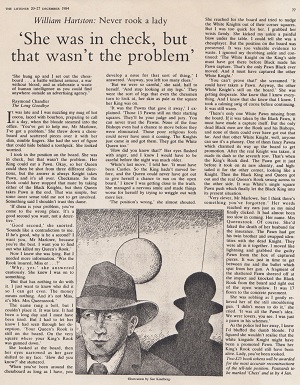
In C.N. 559 William Hartston presented this quote from a 1960 paper by Dr Félix Martí Ibáñez:
‘To checkmate the opponent’s king in chess is equivalent to castrating and devouring him, becoming one with him in a ritual of symbolic homosexualism and cannibalistic communion, thus responding to the remnants of the infantile Oedipus complex.’
We now note a slightly earlier appearance of the passage, on page 504 of Martí-Ibáñez’s book Centaur: Essays on the History of Medical Ideas (New York, 1958). It is in an essay ‘On the Psychology of Chess’ (pages 501-508):
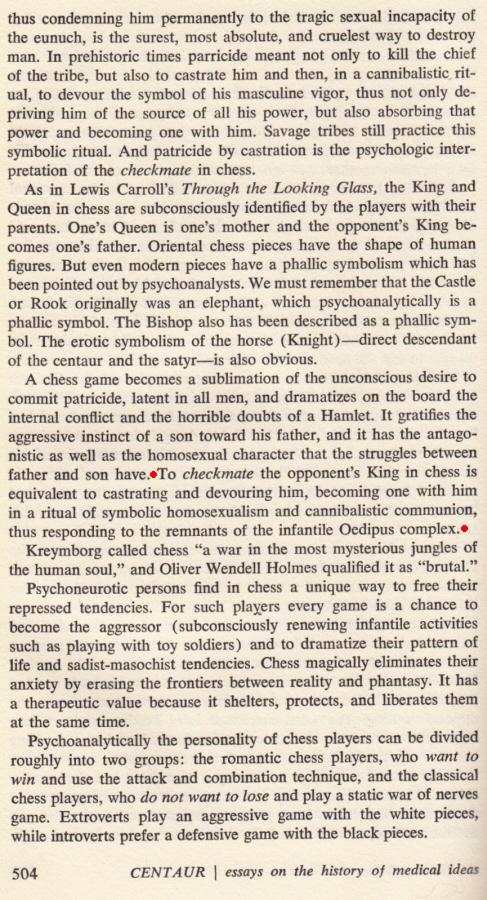
The author’s inscription in our copy:
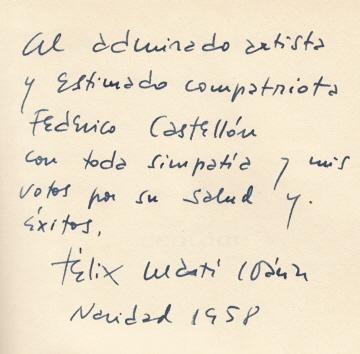
(7456)
The Psychology of Chess by W.R. Hartston and P.C. Wason (Batsford) tackles head-on the remarkable spread of issues which fall within the psychologist’s brief, cheerfully admitting that such riddles as the weakness of women or the strength of Jews in the game offer no simple solutions. But even inconclusive speculation can be highly entertaining when, as here, it is intelligently carried out in crystal-clear language. The strengths of Hartston and Wason highlight the defects of Fine. We would perhaps have preferred to see a more updated treatment of Morphy in the Batsford work, as well as some consideration of the contrast or contradiction that often exists between a player’s temperament and his chess style (the cliché example here is the mild-mannered attacker Rudolf Spielmann).
(744)
It seems a good while since an outstanding elementary text book appeared in English, so Teach Yourself Chess by William R. Hartston (Hodder and Stoughton/McKay) is a pleasure to recommend.
There was an earlier work with the same title, by Gerald Abrahams, but the entirely new 1985 version is much more straightforward and enjoyable. The text would appear to have been read over again and again to eradicate the slightest ambiguity or confusion, with the result that in many respects the book could hardly be bettered.
It is agreeable to see that neither history nor compositions is neglected (though a minor quibble regarding the former: it is a little hard on Euwe that he is the only world champion not even mentioned in the Illustrative Games chapter).
(1034)
In C.N. 1072 William Hartston quoted from the Evening News (London), 5 December 1921 regarding a court case in which William Winter was sentenced to six months’ imprisonment for seditious speeches. See pages 124-125 of Chess Explorations and Chess in the Courts.
An extract from C.N. 1723, concerning material on sale in connection with performances of CHESS The Musical in London:
The most interesting item was a book Chess The Making of the Musical by William Hartston. Published in 1986 by Pavilion Michael Joseph, London, it has been ignored by chess magazines and book-dealers. In addition to the inside account of how the show was produced (illustrated with dozens of excellent colour photographs), the book contains a fair amount of popular chess history. Hartston’s comic inventiveness is as sharply tuned as ever.
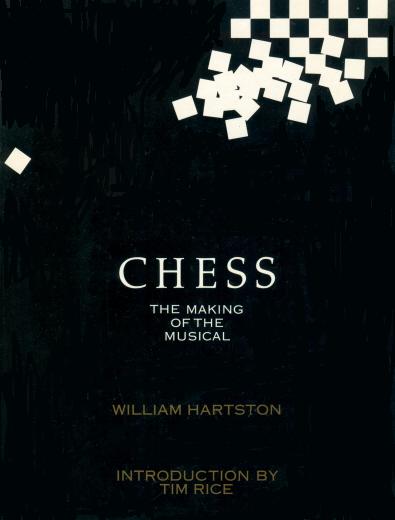
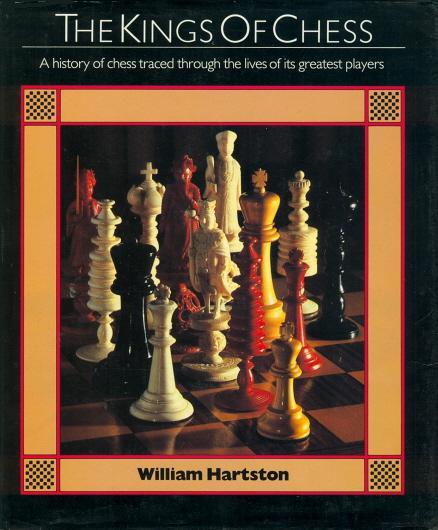
A three-part review of William Hartston’s The Kings of Chess (London, 1985) was written by G.H. Diggle in Newsflash, October, November and December 1985 and reproduced on pages 28-33 of volume two of Chess Characters (Geneva, 1987):
October 1985:
‘On receiving an enthusiastic “tip-off” from that sagacious source, the Chess Editor of the Luton News, the BM lost no time in procuring The Kings of Chess by William Hartston – 192 pages, 15 chapters, and over 100 illustrations, with jacket design by Lawrence Edwards and photography by Ben Johnson. The work, however, is no mere picture book, as the author deals extensively with the careers, characters, contests and controversies of world champions ranging from Philidor to Karpov. As this ground has been covered before – Championship Chess by Sergeant (1939), Kings of Chess by William Winter (1954) and World Chess Champions by Edward Winter (1981), the BM did wonder whether Mr Hartston would have anything new to tell us. In fact, he tells us a great deal – fresh light has been thrown on sundry shadowy episodes of chess history, and there are many shrewd Hartstonian estimates of the great figures who bestrode the chess world during the last 200 years.
To compile a book consisting of individual chapters on successive champions is not as easy as it sounds – their careers are so heavily intertwined that the author has to be constantly on his guard to avoid repetition. However, Mr Hartston has skilfully avoided ever telling the same story twice. Also, though he very occasionally intersperses illustrative games (13 in all, annotated, but not too hoary, apart from our old friends “the Duke and the Count”) they are usually given at the end of each chapter, and not allowed to barge in and dislocate the easy flow of the narrative. In fact, The Kings of Chess is less technical than its predecessors quoted above, and nine-tenths of the book is eminently readable even by a non-chessplayer. The style in which the author treats the “Great Departed” – and indeed the “Still Surviving” – is on the whole kindly, though (as in the lighter How to Cheat at Chess and Soft Pawn) it drips with a sort of harmless malice. Thus, when after dealing with the disagreeable disputes of Steinitz and Zukertort, and later of Capablanca and Alekhine, the author then comes to their amiable successor Dr Euwe, he regards him as a round peg in a square hole and sardonically enquires: “How can such a pleasant chap be a world chess champion?” Again, writing of the absurd dismantling of Fischer’s and Spassky’s match chairs in search of possible “electronic devices”, Mr Hartston is inclined to rap the investigators for negligence, his complaint being that though two dead flies were discovered “no autopsy was performed”.
But the author seems to evince no real dislike of any of the subjects he portrays. This is perhaps not surprising, as when asked on “Karpov v Kasparov” TV recently, “Do you think that a chessmaster finds it a spur and an advantage if he hates his opponent?”, he simply replied, “I don’t know. I’ve never hated anyone”.
The design and photography of the illustrations are admirable. Over half are portraits, and the pudding seems over-egged in certain cases – no fewer than five of Capablanca and six of Alekhine. On the other hand, there are some fine rarities – collective tournament portraits and sketches of Paris, 1867 and London, 1883, and there are even reproductions of old cigarette cards depicting Steinitz and Zukertort at the time of their match in 1886. Many 1972 cartoons of the Fischer-Spassky era appear, and above all there is a very rare contemporary one of Staunton’s final victory over Saint-Amant, with his supporters singing the National Anthem in the background.
Next month the BM hopes to indulge in a few obtrusive comments on what the author has to say about some of the individual masters.’
November 1985:
‘Of no other “King of Chess” have there been more diverse estimates than those of the first one, François André Danican Philidor. Mr Hartston sums him up cautiously, pointing out that all his surviving games were played long after he was in his prime, but adds that his famous Analyse du jeu des échecs, written in his early 20s, assures his place in chess history, if more as a writer than a player. The BM would add that one old French amateur, the Chevalier de Barneville, who had played both Philidor and Labourdonnais, opined that the latter could have given Philidor pawn and two. Other disparagers suggest that, having “hit the jackpot” with one happy punch-line “Pawns are the soul of chess”, he was canonized ever after. But this ignores his “blindfold” skill, his fine endgame analyses (rook and bishop v rook in particular) and the undoubted fact that, though his contemporaries may have been nothing to write home about, he stood head and shoulders above them all for 50 years.
Coming to “renowned Deschapelles”, the author, with – as he says – little evidence to go on outside nine (not very impressive) surviving games, shrewdly surmises that the gasconading Frenchman must have been the strongest player of his time, otherwise no-one would have put up with his “appalling arrogance and unbelievable boasts”. It is indeed true that the chess community, even of those days, would almost certainly rumble any upstart who relied solely on his mouth to reach the top. Yet one feels that if anyone could get away with it, it would be Deschapelles. For like Mr Bounderby in Hard Times, he could not only sing his own praises but somehow stimulate other men to join in – “there was a moral infection of claptrap in him”. Thus George Walker, who had never played Deschapelles or even seen him play, declared: “Deschapelles’ wonderful talent is the most keenly excited in crowded positions. Here that which is Cimmerian darkness to the bystanders is to him light as noon.” But to the student of games, Boncourt rather than Deschapelles was the “Grand Old Man” of French chess.
Next comes the great Howard Staunton, whom the author describes as a deep strategist, with an understanding far ahead of his time, but living in an era when tactics were still the rule. Though he does not minimize Staunton’s pomposity and his “indisposition” whenever the day was against him, Mr Hartston is quite fair to the great man except at one point. Writing of the illness in 1844 which prevented the third match with Saint-Amant, the author says: “Whether the illness was genuine, or a convenient excuse, it is hard to judge.” But it was undoubtedly genuine. All the “archives” dealing with this illness are not readily accessible, but they reveal decisive corroborative evidence from such respectable sources as Captain Wilson (Staunton’s second) and T.J. Bryan, the wealthy and generous American who befriended him during his convalescence. In fact, Staunton never pleaded illness to avoid a match, though he undeniably pleaded it whenever he lost one. The BM has one satirical pamphlet, written after the 1851 tournament, which describes how (in the pro-Staunton press) “the Great Athlete of Calculation” having beaten Horwitz “in Cloud Compelling style”, suddenly shrivelled in the next round against Anderssen into “an invalid, utterly unfit by suffering and physical exhaustion to maintain his reputation in these encounters”.
Dealing with “Morphy, the Unhappy Genius”, the author, who has availed himself of David Lawson’s great work, convincingly rebuts the idea prevailing amongst many previous “pundits” (including, alas!, the BM) that Morphy’s fits of aversion to chess as early as 1858 were the first signs of persecution mania. “His irrational phases”, W.R.H. points out, “formed only two short periods of his life”, and the first symptoms “only appeared 15 years after he had renounced chess”.
On Wilhelm Steinitz, with his ferocious journalism and his extreme unpopularity in this country, the author throws some interesting light. According to Mr Hartston, Victorian snobbery was as much to blame as Steinitz. “A complex etiquette prevailed in the Clubs, whereby any foreigner was received with open arms as long as he was sufficiently deferential to his hosts.” Steinitz failed to maintain the required standard of “’umbleness” and was ostracized accordingly. With all his violent temper, he seems to have been a warmer hearted man than his great rival Zukertort, and less of an exhibitionist. O.C. Müller, a fellow professional of the 1880s, surprisingly writes (BCM, November 1932): “I always found him ... very amiable but of a rather quiet and retiring disposition. ... He did me various good turns ... and he will for ever live in my memory as a kind friend and one of the greatest chess masters of the last century. The last time I saw him was during and after the Aquarium Tournament in 1899, when he spent a week or so in my house before returning to New York, where he died in 1900”.’
December 1985:
Mr Hartston devotes two chapters to Emanuel Lasker, in which he conveys to the reader admirably the atmosphere of genius mingled with bluff and tightrope walking which pervaded the great master’s long career. In tournaments, writes W.R.H., he was always “viewing the game as if looking over his opponent’s shoulder”. He would make bad moves with a straight face just to keep the man opposite suspicious, hesitant and uncomfortable. As the author brilliantly puts it, he “led his opponents through quagmires of unresolved tension until they sank under the weight of their own worries”. (BM footnote: Even as an authority and “pundit” he would sometimes pull the wool over people’s eyes. When an eminent chess author once asked him whether posterity had awarded too much praise to Steinitz and too little to Staunton, the wily Doctor, whose Manual reveals no indication that he had ever studied Staunton at all, gravely “agreed that it was possible”.)
Capablanca in his youth was by no means blind to his own genius, and Mr Hartston entertains us with divers “illustrative quotations” from My Chess Career. But his sense of fun runs away with him in recommending the book as “compulsory reading for students of chess vanity” – it caters equally for students of chess. Moreover, he might also have quoted some of Capa’s notes to his six losses published in Chess Fundamentals, justly described by W.R.H. as one of the finest elementary treatises ever written on the game. The notes are honest, free from bias and not ungenerous. For example, v Znosko-Borovsky (an unexpected loss against an inferior master) where Staunton would have said “The play on both sides is incredibly weak” (S. 0 Horwitz 1) Capa writes: “Black deserves great credit for the way in which he conducted this exceedingly difficult defence. He could easily have gone wrong any number of times, but from move 22 onwards he always played the best move.”
Coming to Alekhine, the author again does not ignore the debit side, particularly when dealing with “The Great Chess Feud” (with Capablanca). But except in this particular field, Alekhine never struck the BM (who observed him at several congresses) as a venomous or arrogant man, and his demeanour towards Badmasters and Plebeians was by no means that of a Coriolanus. The curious thing was that though he undoubtedly hated Capablanca (a defeated rival from whom he had won the title) he never bore the slightest ill-will to Dr Euwe, by whom he was so unexpectedly toppled in 1935. At the beginning of the Nottingham Congress last round in 1936, Euwe (though still world champion) was in some danger of not getting into the prize list, while Alekhine himself (who had the bye) was already out of the running unless Euwe, Fine and Reshevsky either drew or lost. In the event they all won, Euwe being extremely lucky not to have lost against Sir George Thomas. Yet the BM saw Alekhine walk up to the champion afterwards, and with a pleasant smile shake him warmly by the hand.
And now the author arrives at “the land of the living”. His chapters 11, 12 and 13 on the conception, organization and planning of Soviet Chess Supremacy, founded by that sinister but remarkable man, Nikolai Krylenko, State Prosecutor of the 1920s and 1930s, are among the most gripping of the book. And of all the Soviet world champions “the system” has produced, Mikhail Botvinnik emerges, if not the greatest player, the greatest national figure and institution – a sort of Bank of England of Russian Chess; the hallmark of continuity. Twice temporarily deposed, he at once fought back and regained the throne – his prestige never seemed to suffer from an occasional reverse – and to have maintained the successive friendships and confidence, first of Krylenko and then of Molotov, throughout a rugged and chaotic period covering 15 years, denotes a man of exceptional character.
The news has just come through that the last great figure in Mr Hartston’s story, Anatoly Karpov, is world champion no more, having gone down to the youngest man who has ever earned the title (if we except Paul Morphy). The BM’s favourite newspaper (of a true blue texture, of course) expatiates with some relish on the Kremlin’s supposed embarrassment at the result, and concentrates joyously on ringing in the new champion rather than ringing out the old, who is depicted as fading from our sight in a mist of doubt and “shame”. But in his final chapter Mr Hartston has this to say of the man who, though he succeeded to the title by default, held on to it unflinchingly for the last decade: “Anatoly Karpov had emerged from the Soviet cauldron just when he was most needed ... [He] became the most active world champion for many years, and the most successful of all time. He travelled from tournament to tournament, playing all his most dangerous opponents, only very rarely failing to take first place.”’
(8134)
For our (more critical) comments on the book, as well as the subsequent discussion with William Hartston, see The Kings of Chess.
On page 377 of Kings, Commoners and Knaves, only the start of our observations (C.N. 1049) was quoted:
The Kings of Chess by William Hartston (published by Pavilion/Michael Joseph, London, 1985) is subtitled ‘A history of chess traced through the lives of its greatest players’. It is excellently produced, richly illustrated and extremely well proof-read. Hartston’s style is fluent and mordantly witty. He can time a quip as well as anybody around, as is shown by the following deliciously irreverent comment on a particularly tedious phase of the 1984-85 Karpov-Kasparov match:
‘The most exciting event in the Hall of Columns during this period was when the match was adjourned for a week to give way to the lying-in-state of Marshal Ustinov, the Soviet minister who had died without waiting for Karpov’s sixth win.’
Many anecdotal books (the latest being The Kings of Chess by W. Hartston, page 67) attribute to Steinitz the sharp questioning quip about a monkey examining a watch. This is given on page 37 of the February 1890 International Chess Magazine, but Steinitz is not the speaker. The words were said by Mr Schüll of the Liverpool Chess Club, and are reported by Burn in a published letter to Steinitz.
(1077)
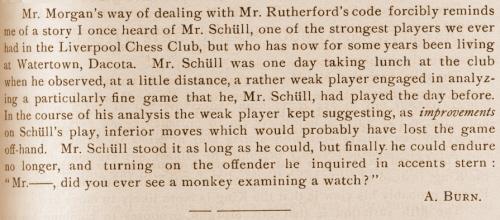
From page 57 of The Kings of Chess:
‘Steinitz defeated Dubois [in 1862], to begin the most impressive match record in the history of chess.’
(9445)
Page 76 of the Radio Times, 2-8 August 1986 had a racy, pseudo-historical chess article by Hartston entitled ‘Knights of the square table’:
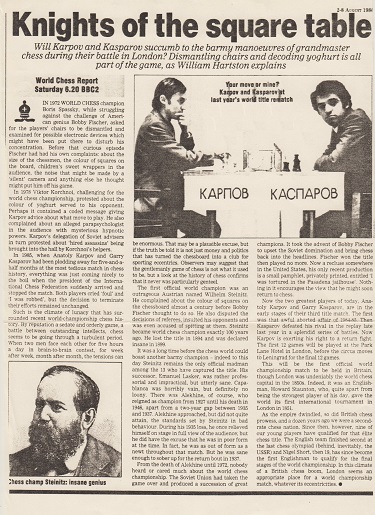
From our Wanted feature article:
There currently exists no single volume on the general history of chess which can be regarded as wholly recommendable (i.e. for being authoritative and readable). H.J.R. Murray’s 1913 work A History of Chess more or less breaks off when personalities increasingly emerged (in the nineteenth century), and much of it has, in any case, proven indigestible. On page 189 of The Kings of Chess W.R. Hartston called it ‘900 pages of meticulous research, practically unreadable’.
In Kingpin in 1997 and 1998 we touched on the topic of unusual dedications in chess books (see page 237 of Kings, Commoners and Knaves). George Cadden (Newport, Wales) drew attention to the following, one of three dedications in Hartston’s How to Cheat at Chess:
‘To the memory of the humourless chess author; may his royalties plummet.’
From our feature article Ricardo Calvo: Persona non Grata:
Concerning the issue of FIDE rules on pairing players from the same country, Raymond Keene’s Spectator column of 18 August 1990 (page 52) criticized ‘two jokers from the British Chess Federation, David Anderton and William Hartston’.
Pages 257-292 of Letters from London by Julian Barnes (London, 1995) featured an article about the 1993 Kasparov v Short match, and on page 282 he reported, ‘I lunched some observations out of the international master William Hartston’. One of these, on page 284, is an intriguing theory:
‘The history of the world chess championship shows that the way to beat a great player is to allow him to indulge his strengths in unfavourable circumstances.’
(3248)
Imitations and parodies of the Holmes stories are not infrequent and three good ones with a chess connection come to mind. The most recent is ‘The Case of the Mental Detective’ by William R. Hartston, on pages 25-30 of his book Soft Pawn (London, 1980).
(3531)
See too Chess and Sherlock Holmes.
On 7 February 2005 the UK television programme Mind Games (BBC Four) had William Hartston as a guest contestant. He was in fine form in the face of a thorny set of braintwisters. For instance, cuboid is a three-dimensional shape with six faces but also a word with six letters, and the teams were required to name another three-dimensional shape with the same number of faces as letters. It was Hartston who supplied the answer: dodecahedron (12 faces, 12 letters).
When he last did chess on television we do not know, but he is certainly the best presenter of the game we have seen.
On pages 83-86 of How to Cheat at Chess (London, 1976) William R. Hartston offered advice on the art of annotating:
‘... For the benefit of the potential writer who may find himself forced to provide notes to some game he does not comprehend, we end this short course with a typical annotated game. All the notes (with very slight modifications where necessary) have actually appeared in chess journals during the past few years; most of them will probably appear again in the course of the next few years for they all bear the trade mark of an expert notewriter, in that they convey no precise information about the position and have that all-purpose look about them which is so useful when you feel like writing a note, but do not know what to say. We hope the reader will himself make full use of these notes when annotating games himself; in view of the forthcoming world shortage of original notes, he should find all he needs in this short game.’
Hartston then gave the 1 d4 e5 2 Qd2 version of the composed stalemate game (C.N. 3679), annotated with such observations as: ‘When Black can play this move safely he invariably solves his opening problems’, ‘Other lines cause the defence little difficulty’, ‘Those who are familiar with the teachings of Nimzowitsch will recognize his influence on the central play in this game’ and ‘This position had undoubtedly been foreseen by both players’.
But now Alan O’Brien (Mitcham, England) points out to us that most, if not all, of the 24 notes used by Hartston were taken from a single writer, i.e. from the two ‘Play the Experts’ Way’ articles on pages 75-77 of the March 1970 BCM and pages 100-103 of the April 1970 issue (the games Tukmakov v Tal and Jacobsen v Ljubojević). The articles were by W. Ritson Morry.
(3883)
From William Hartston:
‘All I can say to your correspondent is: well-spotted. That chapter of How to Cheat at Chess was based on an article I’d written earlier for Dragon (the magazine of the Cambridge University Chess Club) called “Write Notes The Expert’s Way” as a parody of Ritson Morry’s banalities in his BCM column. I’m not sure how many changes I made for the book – unlike some writers, I’m not a great fan of cut-and-pasting – but the basic material for that bit of the book certainly came from the Dragon article.’
(3886)
Occasional C.N. items refer to chess figures who have penned non-chess books, and one of the most successful nowadays is William Hartston, with several works on general ‘trivia’. The best of all, in our view, is his 2005 volume What’s What (subtitle: ‘The Encyclopedia of Pointless Information’). Chess has a brief entry, but elsewhere we learned that ‘one ounce of cress boiled down will produce enough cyanide to kill two mice’; that ‘forty is the only number which, when spelled out in English, has its letters in alphabetical order’; that ‘when [George I of England, who did not speak English,] needed to communicate with his prime minister, Robert Walpole, they spoke Latin’; that ‘there are no reptiles, amphibians or poisonous animals in Iceland’; that ‘Paraguay is the only country with a national flag that is not the same on both sides’; that ‘all polar bears are left-handed’; and that ‘in 1812 ... February had 30 days in Sweden’.
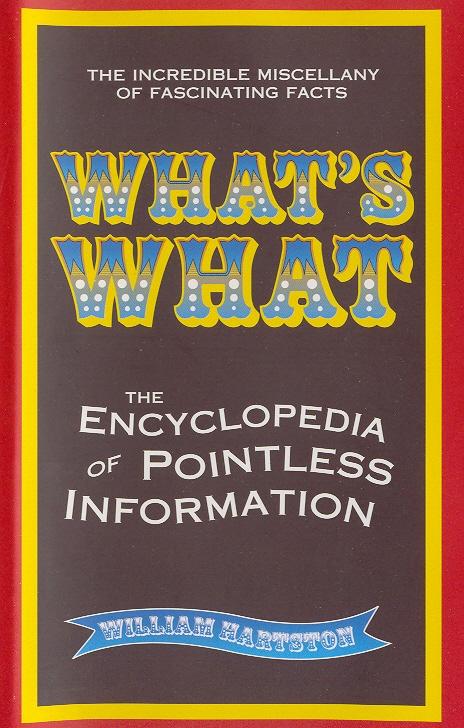
(3911)
The first field to have a world champion is a question broached in C.N. 3030 (see page 269 of Chess Facts and Fables) and discussed in items on draughts/checkers (C.N.s 4413, 4418 and 4434). An interesting addition comes from page 46 of a book mentioned in C.N. 3911, What’s What by William Hartston (London, 2005):
‘In 1873, billiards became the first game or sport to hold an official world championship. It was won by a Frenchman called Gamier. The second recreation to have a world championship was chess in 1886.’
Concerning the billiards event, particulars from contemporary sources will be welcomed.
A new edition of What’s What, slightly amended, has just been published under the title Mr Hartston’s Most Excellent Encylopedia of Useless Information.
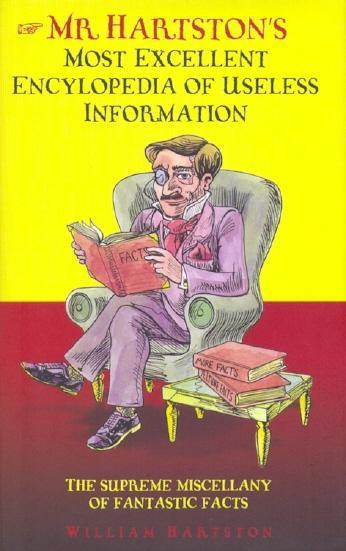
The fact that the title has the spelling ‘encylopedia’, and not encyclopedia, throughout (on the dust-jacket, the cover, the title page and the running head on odd-numbered pages) is likely to be regarded, in a Hartston volume, as an in-joke. After all, the back cover of his 2004 book What Are The Chances Of That? mentioned that his surname is often misspelt, whereas the title page appeared thus:
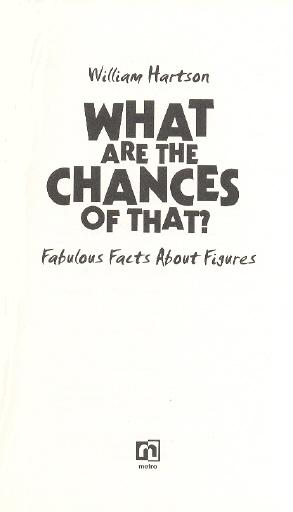
(4603)
William Hartston writes:
‘The spellings were not in-jokes. The missing “c” in encyclopedia was just a huge blunder by the publishers. Anticipating questions about it, I prepared two answers: a) it’s the American spelling; b) it’s a deliberate misprint in order to make the first edition more valuable.
The misspelling of Hartston was just as accidental, and slightly less forgiveable. I never saw the title page of What Are The Chances Of That? pre-publication, so did not have an opportunity to spot the misspelt name. They did send me a copy of the jacket of the “Encylopedia”, but I suspect that I was so relieved at seeing Hartston spelt correctly that I did not notice the blunder.
If there is another edition of What Are The Chances Of That?, I shall include in the entries for the numbers 1 and 216:
1 – number of “t”s missing from Hartston in the title page of the first edition of this book.
216 – number of times “encyclopedia” is misspelt in Mr Hartston’s Most Excellent Encylopedia (sic) of Useless Information.
On the subject of spellings, I now understand that the French billiards player I mentioned was (Albert) Garnier, not Gamier.’
(4604)
Regarding our feature article on Sultan Khan Leonard Barden comments on the following passage quoted by us from page 215 of The Guinness Book of Chess Grandmasters by W. Hartston (Enfield, 1996):
‘Eighteen years later, however, [i.e. in 1951] when he [Sultan Khan] was shown the moves of the games in the world championship match between Botvinnik and Bronstein, he is reputed to have dismissed them as the games of two very weak players.’
After mentioning that the source of this reputed dismissal was unknown to us, we also quoted William Winter in CHESS, February 1963, page 148:
‘I remember vividly my first meeting with the dark-skinned man who spoke very little English and answered remarks that he did not understand with a sweet and gentle smile. One of the Alekhine v Bogoljubow matches was in [a] progress and I showed him a short game, without telling him the contestants. “I tink”, he said, “that they both very weak players.” This was not conceit on his part. The vigorous style of the world championship contenders leading to rapid contact and a quick decision in the middle game was quite foreign to his conception of the Indian game in which the pawn moves only one square at a time.’
Leonard Barden informs us:
‘Hartston’s story about Botvinnik-Bronstein had appeared in one of my columns. My own source was the Pakistani A. Kitchlew, a strong player who competed in the Hastings Challengers’ tournament in the 1950s and 1960s and a few years ago won a lower section at Jersey when in his eighties. Kitchlew and I both played for the Linguists Club of Kensington, London, team in the National Club Championship around 1956, and he then told me that he knew Sultan Khan and that Sultan had indeed made the comment I quoted. I had and have no reason to believe he was embellishing the tale.
It seems quite a reasonable remark from a world-class player about the 1951 match, where the quality was uneven.’
(5037)
Page 197 of The Guinness Book of Chess Grandmasters by William Hartston (Enfield, 1996) quoted a familiar old quip:
‘By the time FIDE organized the world championship tournament in 1948, Fine had begun to shift his attentions from chess to a career in psychoanalysis. He declined an invitation to the 1948 event because it clashed with his final exams. His decision was later described by one wit as “a great loss for chess and at best a draw for psychoanalysis”.’
Who first made that remark, and where?
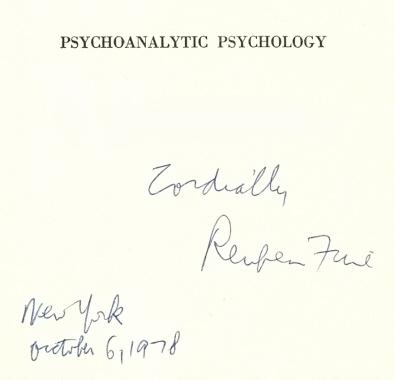
(5238)
We now note that the familiar comment about Reuben Fine was made by Gilbert Cant in an article ‘Why They Play: The Psychology of Chess’ on pages 44-45 of Time, 4 September 1972:
‘When Fine switched his major interest from chess to psychoanalysis, the result was a loss for chess – and a draw, at best, for psychoanalysis.’
The full article can be read on-line via the link to Time given in C.N. 5819.
(6090)
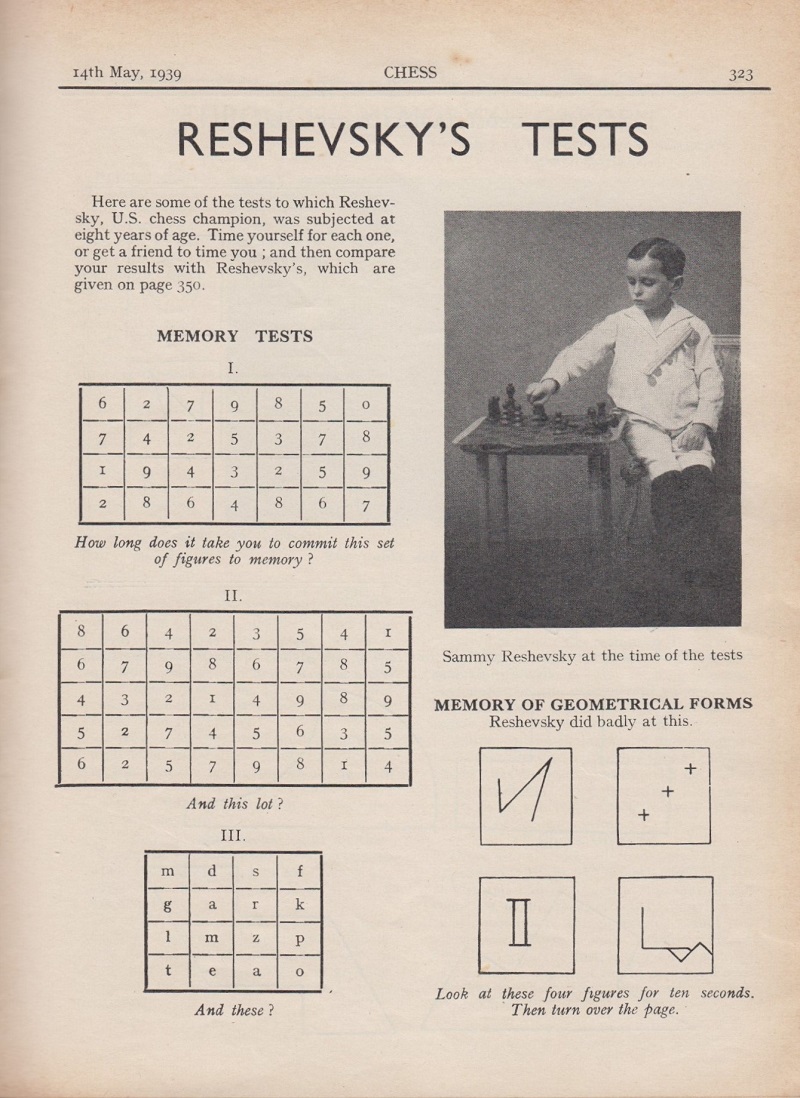
Testing Reshevsky notes that there was some discussion of the topic on pages 26-27 of The Psychology of Chess by W.R. Hartston and P.C. Wason (London, 1983).
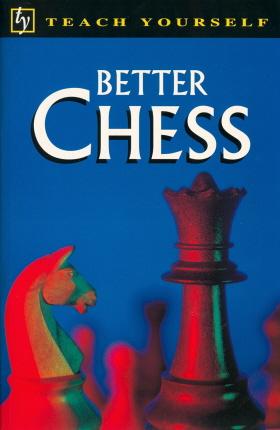
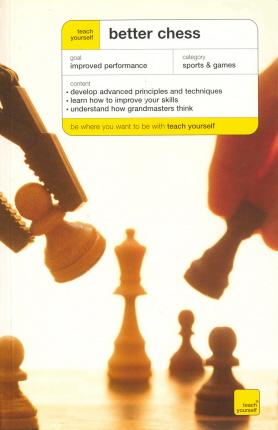
A finely-written book, seldom discussed, forms part of the ‘Teach Yourself’ series: Better Chess by William Hartston (London, 1997 and 2003). The page numbers in our selection of quotes below refer to the latter edition:
(5884)
Regarding the above-quoted remark (C.N. 5884) ‘Think strategies when it’s your opponent’s turn to move; sort out the tactics while your own clock is running’, Paul Dorion (Montreal, Canada) notes a passage on page 139 of Think Like a Grandmaster by Alexander Kotov (London, 1971):
‘When later I was busy writing this book I approached Botvinnik and asked him to tell me what he did when his opponent was thinking. The former world title-holder replied in much the following terms: Basically I do divide my thinking into two parts. When my opponent’s clock is going I discuss general considerations in an internal dialogue with myself. When my own clock is going I analyse concrete variations.’
(5889)
C.N. 5884 quoted a couple of sentences about planning from page 28 of Better Chess by William Hartston (London, 2003). The full section is worth recalling:
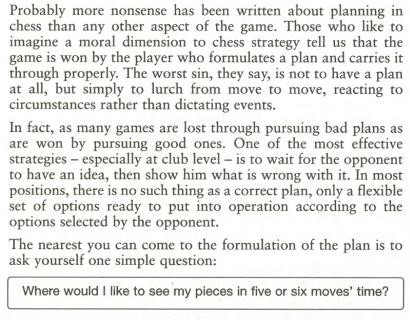
Another notable comment is on page 22:
‘The “knights before bishops” nonsense is a specific case of a much more sensible piece of advice on development: Play the obvious before the optional.’
(6694)
See also Chess Planning.
What is a Chess Combination? includes this definition from page 211 of Chess by Bill Hartston (London, 1996):
‘A sequence of moves involving more than one piece that leads to strategic or tactical gains.’
On the question of whether to go ahead with a risky combination or settle for a more placid line, C.N. 62 quoted a proposal on page 39 of Hartston’s How to Cheat at Chess (London, 1976).
He gave the formula V equals G over n squared minus S, and the explanation included the following:
‘This formula applies to any combination calculated by the Average Club Player.
G is the expected gain in material if all one’s calculations are correct.
S is the amount of material sacrificed.
n is the number of moves deep to which one has been forced to work things out and the formula is applied to calculate V, the value of the combination.
If V is greater than zero, you cross your fingers and play it, but if V is negative you would only be inviting disaster by continuing on the calculated path.’
A position from page 75 of Better Chess by William Hartston (London, 2003):
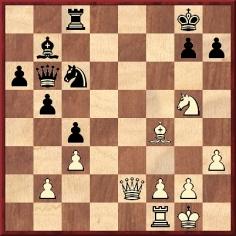
White, to play, gives mate in how many moves?
(5923)
Our feature article on this topic is The Smothered Mate.
William Hartston informs us that he has just begun a website entitled Wakkipedia.
(6413)
The website is no longer on-line.
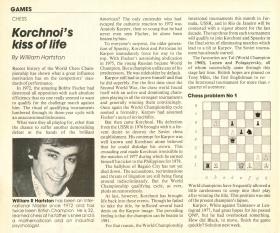
Throughout the run of the weekly news magazine Now! (September 1979-April 1981) there was a fine chess column by William Hartston. Some quotes are offered below:
Some years ago I was playing in the Hastings tournament with Mikhail Tal. One evening, he picked up an English newspaper, casually glanced at the chess column and started laughing. What had attracted his attention was the position given for readers to solve: it was from his own game against Platonov played at Dubna in 1973.
The amusement, however, was caused by the set of par solving times appended in order to rate one’s achievement in finding the answer. These began at 20 seconds, indicating grandmaster strength, then proceeded via master, county player and club player to stop at “average” – five minutes. “That’s very funny”, said Tal. “I spent 15 minutes looking at the position before I saw it, and my opponent didn’t see it at all.”’ (4-10 January 1980, page 98.)
The position in question was given:
White (Tal) to move
Such a game as this [the famous Steinitz Gambit brilliancy won by Robert Steel from the 1880s] gives the impression that calculating ability and imagination in chess are no better now than they were 100 years ago. The game is far more scientific, of course, but for sheer flair and inventiveness such nineteenth-century brilliancies remain practically unparalleled in modern play.’ (25-31 July 1980, page 88.)
All the more enjoyable therefore to come across the rare example of totally honest annotators of their own games. Of today’s great players I put complete trust in Larsen and Tal.’ (8-14 August 1980, page 82.)
(6742)
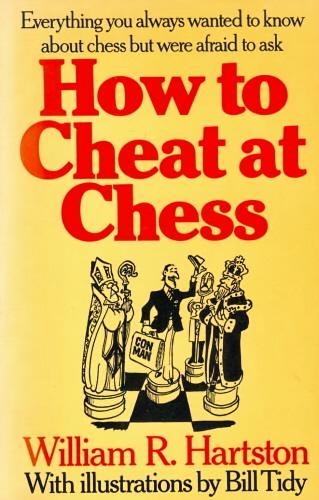
An article by the Badmaster, G.H. Diggle, from the April 1977 Newsflash and page 21 of Chess Characters (Geneva, 1984), began as follows:
‘W.R. Hartston’s disgraceful book How to Cheat at Chess (a work “without which no Badmaster’s bookshelf could possibly be complete”) was lapped up with avidity by the present BM while commuting from Lewes to Victoria. He had omitted to conceal from public gaze the brazenly gaudy title on the cover, and even before reaching Haywards Heath his fellow passengers were exchanging significant glances, while a ticket inspector on the train subjected the BM’s “Season” to a minute scrutiny before allowing him to resume his “nefarious perusal”. The BM, who after 50 years of chess gamesmanship flattered himself that he knew every trick of the trade, is forced to admit that on nearly every page of this comprehensive work some completely fresh specimen of low rascality held him captivated and enthralled.
(6837)
See also Chess Cunning, Gamesmanship and Skulduggery.
William Hartston sends this report from the Beachcomber column on page 8 of the Daily Express, 15 August 1935:
‘Bon Voyage!
Two days ago the English chess team left London for Warsaw to play in the international tournament.
There was no fuss. Indeed, a famous chess player is about the only person in modern life who is not mobbed on sight. If this had been a cricket team men and women would have rushed the station barriers, mayors would have made speeches, and the traffic in this neighbourhood would have been disorganized for four hours. If it had been a Yankee band, mounted police would have charged the crowd, girls would have had screaming hysterics, and the leader of the band would have posed on top of the engine with a magnum of champagne in one hand and a saxophone in the other.
But these were chess players, and they departed in silence, save for a ribald shout of: “Bring us back a Polish bishop!”’
Mr Hartston, we note, has a new book out very shortly: The Things That Nobody Knows. Its subtitle is 501 Mysteries of Life, the Universe and Everything.
(7280)
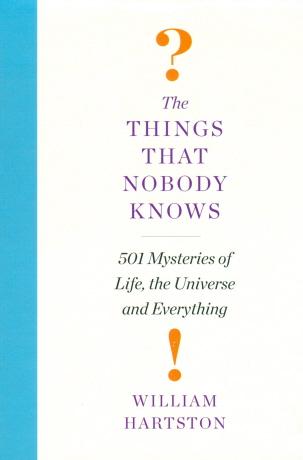
William Hartston’s new book (C.N. 7280) has one item about chess, which we reproduce from pages 166-167 with the author’s permission:
‘What is the result of a chess game if both sides play perfectly?
With best play, the game of noughts-and-crosses (tic-tac-toe in the USA) should end in a draw, as it is not difficult to demonstrate. In the more complex game of Connect Four, it was shown by exhaustive analysis in 1974 that the first player can force a win. The still more challenging game of gomoku (five in a row) was solved by computer in 1994, showing that the first player may again force a win with best play. But what about chess?
Results from international tournaments have supported the general view that White, who moves first, has an advantage, with results for White around 2 or 3 per cent ahead of Black. With around 10120 possible chess games (which is significantly more than the number of atoms in the universe, estimated at around 1080), a complete analysis of chess is currently impossible. Whether White’s advantage is enough to win, or whether Black can defend himself, or whether indeed with best play Black should actually win, at present appear to be unfathomable questions.’
It is certainly a widely discussed issue. Two passages from nineteenth-century books may be mentioned here, the first being on page xxxi of The Modern Chess Instructor by W. Steinitz (New York, 1889):
‘In fact it is now conceded by all experts that by proper play on both sides the legitimate issue of a game ought to be a draw, and that the right of making the first move might secure that issue, but is not worth the value of a pawn.’
From pages 74-75 of Maxims and Hints by R. Penn (London, 1842):
‘Every game perfectly played throughout on both sides would be by its nature drawn. Since, then, in matches between the most celebrated players and clubs of the day some of the games have been won and lost, it seems to follow that there might be better players than have been hitherto known to exist.’
We recall too the article ‘Quelques réflexions sur la partie idéale’ by L. Roussy which was published, together with comments by Erwin Voellmy, on pages 54-58 of the April 1919 Schweizerische Schachzeitung/Revue suisse d’échecs:
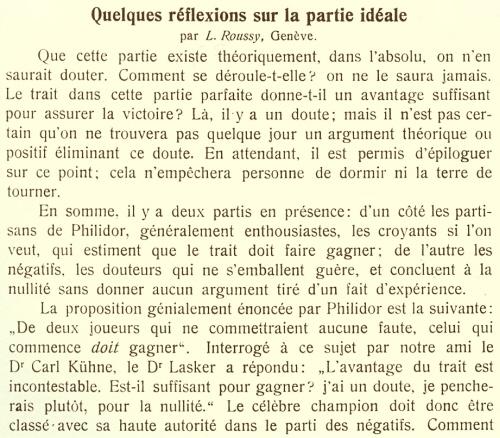
The article also appeared on pages 134-137 of the June 1919 La Stratégie. Page 299 of the September 1919 BCM noted Roussy’s conclusion that White wins a perfectly played game but remarked that ‘M. Roussy does not go so far as to produce an example of a game perfectly played by both sides, in which the victory goes to White’. A book prize was offered by the BCM to ‘the reader who shall be adjudged to have sent in the nearest approach to “perfection”’.
B. Goulding Brown expressed doubts about Roussy’s thesis in a letter on pages 334-335 of the October 1919 BCM but added:
‘... undoubtedly the advantage of first move, added to that gained from one slightly objectionable move on Black’s part, will produce a winning advantage for White, as in the game H.E. Atkins v J.F. Barry (Cable Match, 1910), which I beg to enclose as the nearest that I know to perfection.’
Regarding that game, see pages 142-143 of A Chess Omnibus.
(7306)
The first paragraph of an article by the Badmaster, G.H. Diggle, which was published in the March 1981 Newsflash and on page 66 of Chess Characters (Geneva, 1984):
‘That incorrigible chess satirist, W.R. Hartston, dealing with “etiquette for chessplayers on losing”, recommends (Soft Pawn, page 41) that resignation should be accompanied by “a pertinent congratulatory message” and gives as a textbook example for our guidance: “I hope that makes you happy, you smug bastard.” An alternative worth consideration (which the BM once actually overheard in a League Match) is “Fancy losing to you”, bringing home to the “bastard” that he was not only smug but incredibly lucky.’
(7750)
See too Excuses for Losing at Chess.
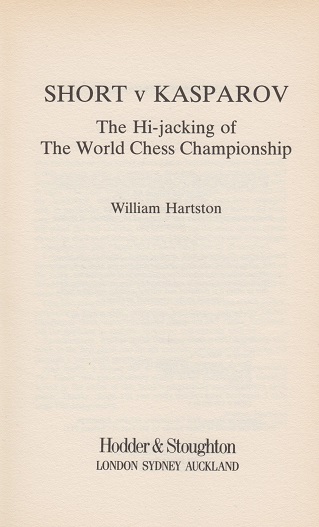
From page 1 of Short v Kasparov The Hi-jacking of The World Chess Championship by William Hartston (London, 1993):
‘The game of chess, with its complexities just beyond the mastery of either man or machine, has always been a refuge for an entertaining mixture of eccentrics, obsessives, dogmatists, pragmatists and even the occasional genius. As competitive as any sport, yet as intellectually demanding as any academic pursuit, it demands of its leading practitioners a dedication approaching monomania.’
As regards the title of the book, in case of divergence our practice is to follow the title page and not the front cover.
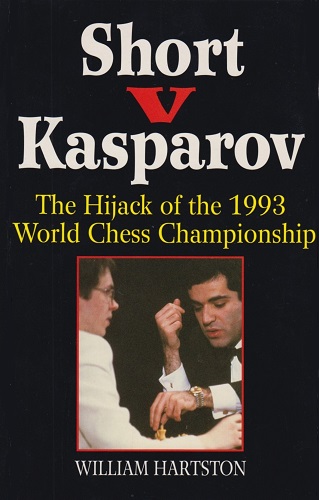
(9001)
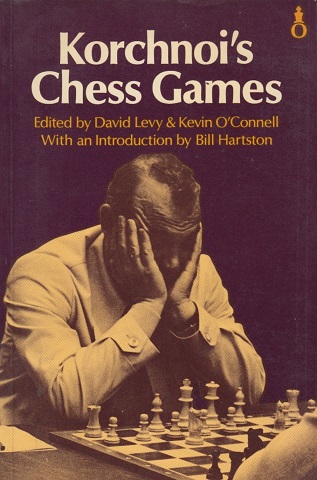
Hartston’s Introduction to Korchnoi’s Chess Games edited by David Levy and Kevin O’Connell (Oxford, 1979) includes these observations (page vii):
‘Among the great players of the world Viktor Korchnoi is unique. When he sits down to a game he brings to bear a combination of concentration, determination and energy which no other grandmaster can match. To Korchnoi chess is above all a fight. While he is playing, all that matters is the result of the game. Friendships are forgotten, problems are shelved; the struggle on the board takes absolute precedence.
This tremendous will to win makes Korchnoi’s games always interesting. Never satisfied with routine play, he seeks strategic complexity, searching for the very best move from the earliest stages of the game. Often this leads him into great time-pressure, but there Korchnoi is supreme. ...
Away from chess Korchnoi is far from being the killer he is at the board. I have always found him one of the most sociable, good-humoured and generous of grandmasters, but never expect this character to show itself during a game. ...
Having passed the age of 45, when most grandmasters are well past their prime and settling down to a less strenuous tournament life, Korchnoi plays with greater vigour than ever. To have maintained his perfectionist approach and energy-demanding style is a great achievement on its own, but to have done so with ever-improving results is almost incredible. But why ponder on the source of Korchnoi’s power when we can enjoy its fruits in his games? Study them well; he put a great deal of work into them.’
(9550)
From page 163 of The Kings of Chess by William Hartston (London, 1985), concerning the 1971 Fischer v Petrosian match:
‘Fischer seemed in a good mood at the start, almost sociable. One journalist found a good description of his manner: “Ordinarily, Fischer is socially evasive rather than hostile, likely to greet even an old friend as if he were expecting a subpoena.”’
And from page 18 of Bobby Fischer Goes to War by David Edmonds and John Eidinow (London, 2004):
‘A journalist wrote that Fischer was likely to greet even an old friend as if he were expecting a subpoena.’
People worth quoting are worth naming. The ‘journalist’ who made the remark, and it is a good one, was Robert Cantwell, on page 31 of Sports Illustrated, 8 November 1971:
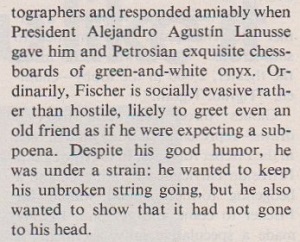
Cantwell’s article, entitled ‘Bobby Clears the Board for the Title’, was on pages 30-32 and 35.
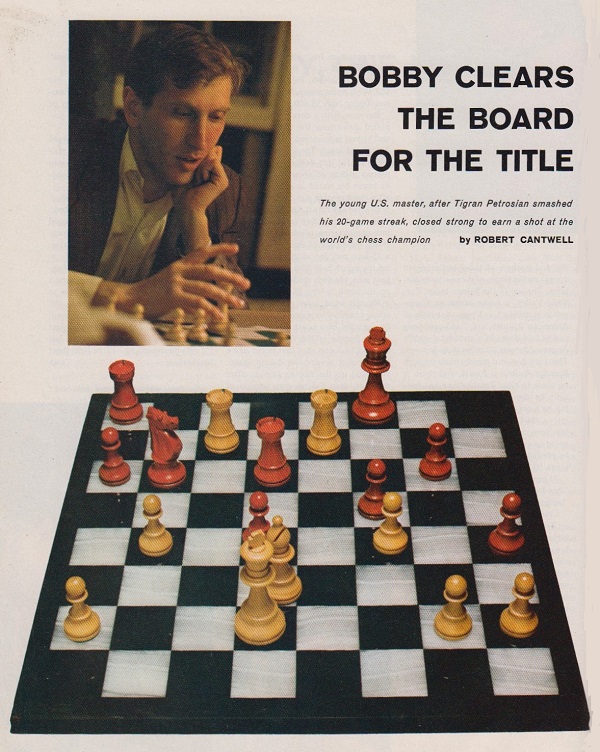
(9814)
A portrait from our collection:
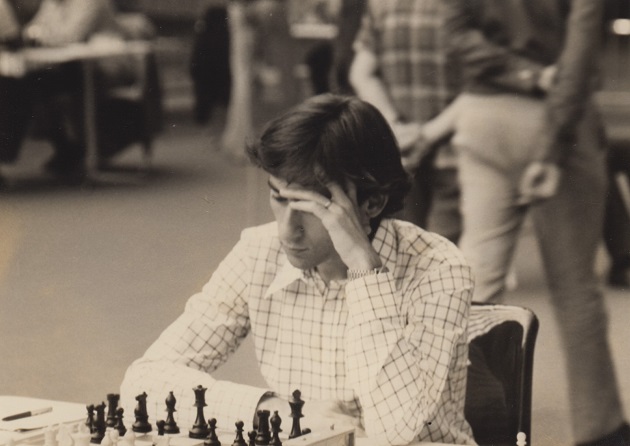
William Hartston
(10007)
In this photograph from our collection, readers may recognize two figures [Hartston and David Goodman], but we have no information about the occasion:
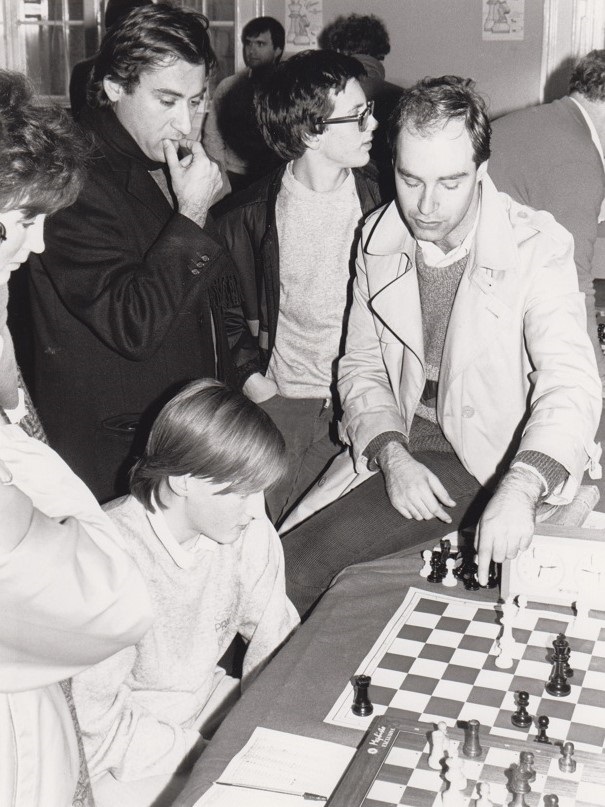
(10236)
‘Chess is not something that drives people mad; chess is something that keeps mad people sane.’
That observation by William Hartston is readily found in chess literature and on the Internet, usually without a source. At best, there may be a reference to Bobby Fischer Goes to War by David Edmonds and John Eidinow (London, 2004). From page 69:

The book’s bibliography lists four works by William Hartston, but in none of them do we see the remark. Mr Hartston informs us that he does not currently recall its exact provenance.
A paragraph on page 104 of The Psychology of Chess by W.R. Hartston and P.C. Wason (London, 1983):

There is, furthermore, this description of chess on page 11 of The Kings of Chess by William Hartston (London, 1985), which we originally gave in C.N. 1381:
‘A game to subdue the turbulent spirit, or to worry a tranquil mind.’
As mentioned on page 377 of Kings, Commoners and Knaves, that observation was included in The Penguin Dictionary of Twentieth Century Quotations by J.M. and M.J. Cohen (London, 1993 and 1995):

(10823)
From page 4 of Short v Kasparov The Hi-jacking of The World Chess Championship by William Hartston (London, 1993):
‘A great deal has been written, at various times and in a variety of different cultures, about the character-forming aspects of chess, how it demands qualities such as patience and foresight that are useful in everyday life, and how the study and play of chess may help to develop those qualities; yet looking at the history of the game and its leading practitioners, one might be excused for reaching a different conclusion: that chess can bring out the worst in people.’
(10832)
From page 149 of CHESS, January 1966:
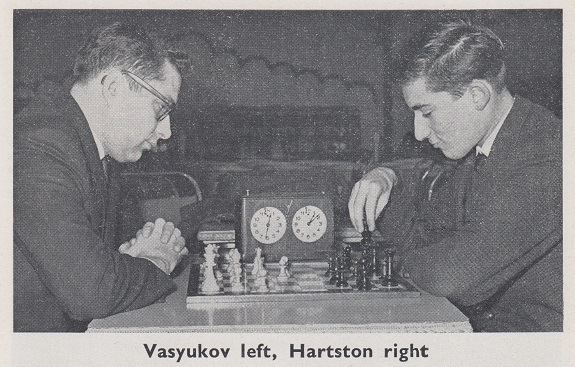
Page 147 gave their game in the Hastings tournament, played on 1 January 1966.
(10839)
‘The history of chess makes no sense.’
That is the opening paragraph of chapter one of Short v Kasparov The Hi-jacking of The World Chess Championship by William Hartston (London, 1993). See page 3.
Three further quotes:
‘Apart from the madness (which only afflicted him in his final years), Steinitz’s intellect was one of the greatest that ever chose to devote itself to chess.’ (Page 15.)
‘Over the years, it was to become apparent that the title of world champion carried with it an almost mandatory duty for new title-holders to squabble with the men they had beaten about the rules for the next contest.’ (Page 28.)
‘FIDE is a United Nations of chess without a Security Council.’ (Page 113.)
Hartston is at his deadpan best when describing how the 1993 Kasparov v Short match was organized and how The Times covered it.
(10840)
Alan O’Brien asks for details of William Hartston’s appearance in the ‘Pseuds Corner’ column of Private Eye, when ‘the magazine did not realize that Hartston was being funny’ (with references to existentialism and a good bad bishop).
We do not have the relevant issue of the magazine, but a search in Google Books provides the text (an attribution by David Spanier in The Times) and shows that it was included, with the name ‘Hartson’, in Private Eye’s Oxford Book of Pseuds (London, 1983).
From page 11 of The Times (Saturday Review), 26 April 1980, in Spanier’s column on that year’s London tournament:
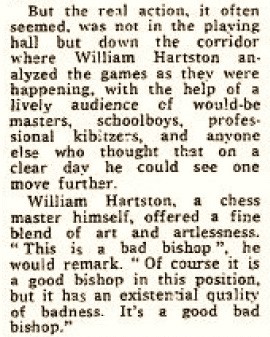
Sections 26 and 67 of Hartston’s fine book Better Chess (London, 1997) are entitled, respectively, ‘The Good “Bad Bishop”’ and ‘The Bad “Good Bishop”’.
An interview by Cathy Forbes with Jon Speelman on page 28 of CHESS, April 1990 stated that a remark of his ‘has even earned him a place in Private Eye’s Pseuds Corner’.
See too Unintelligible Chess Writing and Franklin Knowles Young.
(10850)
C.N. 7769:
A famous Staunton position, from his eighth match-game against Elijah Williams, London, 1851:
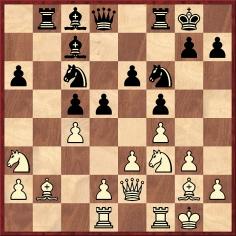
Staunton (White) played 14 Bxf6 Qxf6 15 cxd5 exd5 16 d4.
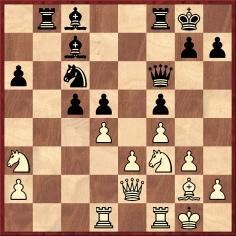
On page 155 of Better Chess (London, 1997) William Hartston wrote after 16 d4:
‘Envisaging this pawn move, White first exchanged his black-squared bishop to ensure that it would not become bad (though it was another 50 years before anyone came up with the concept of a “bad bishop”).’
The topic was pursued in C.N.s 10844 and 11048.
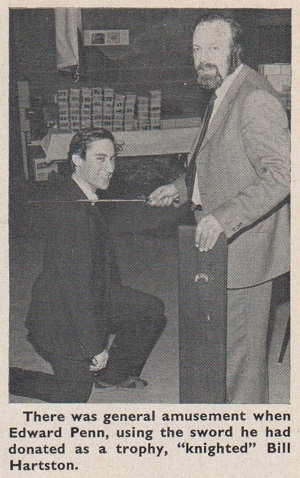
Source: CHESS, September 1973, page 351.
The occasion was a tournament in Enfield, organized by Edward Penn and won by Hartston.
(10971)
Among the points made on page 3 of The Guinness Book of Chess Grandmasters by William Hartston (Enfield, 1996):
This book is about the real Grandmasters.’
(11444)
See too Chess Grandmasters.
From Hartston’s obituary of Harry Golombek on page 12 of the Independent, 10 January 1995:
‘In 1928, Golombek played in his first London Boys’ Championship, finishing last in his section. The next year, however, he won it, an achievement of which he seemed never to tire of reminding his readers ...
Golombek went from Wilson’s Grammar to London University, though there is no record of his having completed his degree.’
C.N. 11158 quoted another line from the obituary:
‘He was awarded the title of International Grandmaster in 1985, which he liked to stress was not an honorary award, but a belated recognition of his playing achievements in the 1940s.’
For a further discussion of these matters, see our feature article on Harry Golombek.
On the topic of rude reviews, William Hartston submits the oldest specimen that we have been able to give so far, from page 237 of the March 1764 edition of the Critical Review, concerning A Poem on Chess by Guy Hawkins:

‘Those who have no idea either of poetry or the game of chess may probably imagine that the author of this piece is acquainted with both; but those who have any skill in them, will easily perceive, on the perusal of it, that he has very little knowledge of either.’
(11593)
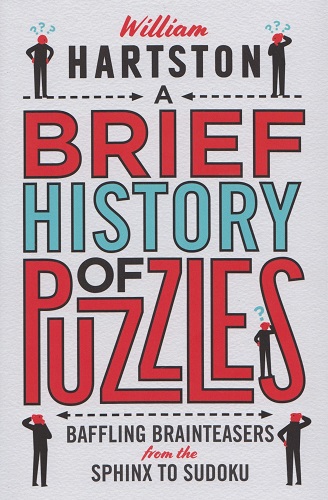
A Brief History of Puzzles by William Hartston (London, 2019) has much chess content, including not only such classics as Sam Loyd’s ‘Excelsior’ problem but also some unfamiliar specimens, of which a sample follows here.
‘What do the following have in common: the musicians Britney Spears, Eric Clapton, Roger Daltrey and Fats Waller; chess grandmasters Nigel Short and Tony Miles; actors Meg Ryan and Tom Cruise; politician Clare Short; TV personality Steve Irwin?
Hint: Aristotle could join them, and Socrates could do so twice.’
‘What do the words sine, ride, chess and chat have in common that is shared by riots, pest and zone, but not in the same place?’
‘I began [at an annual dinner of chessplayers at a London club] by presenting them with the letters A, B, C, D, E, F and asking them which letter was the odd one out.’
‘... Then I posed them a question that is definitely one of my favourites. It demands no chess knowledge [unlike the previous puzzle] and would, by most logicians at any rate, be considered fair:
Which of the following is the odd one out?
KING, king, king, king, queen’
Full solutions are given in the book.
(11617)
See too Chess Puzzles.
Wanted: examples of non-chess words which have been coined by prominent chess figures.
From page 62 of William Hartston’s A Brief History of Puzzles (C.N. 11617):
‘For more than 50 years, crosswords were the only word puzzle that had a universally accepted name, but since the 1970s another has emerged and, in 1999, the new teaser was given a name. The word “ditloid” is not yet in the Oxford English Dictionary, but a Google search for “ditloid” produces tens of thousands of results. I am delighted by this, because it is a word I coined myself and is my only genuine contribution to the English language.’
(11637)
Olimpiu G. Urcan (Singapore) has provided a number of fine photographs of Hartston, reproduced here with permission:
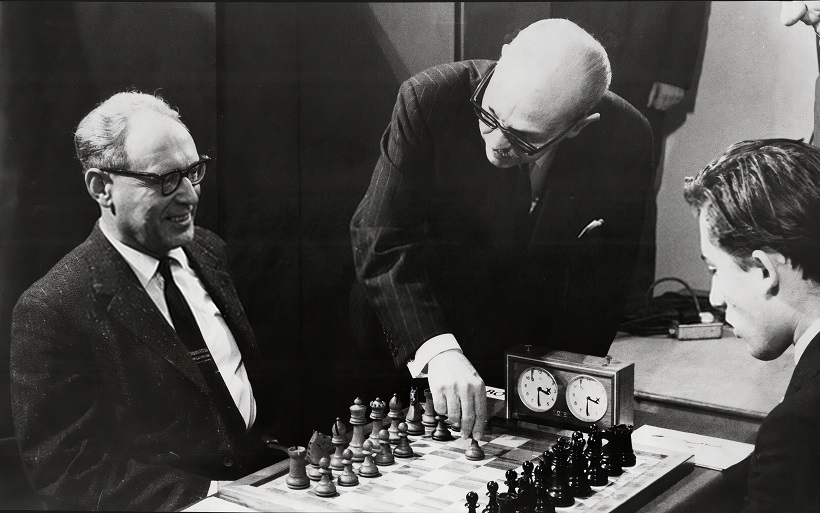
With Mikhail Botvinnik and Jayme Sloan Chermont (the Brazilian Ambassador to the United Kingdom); the opening move at Hastings, December 1966 (Keystone Archive)
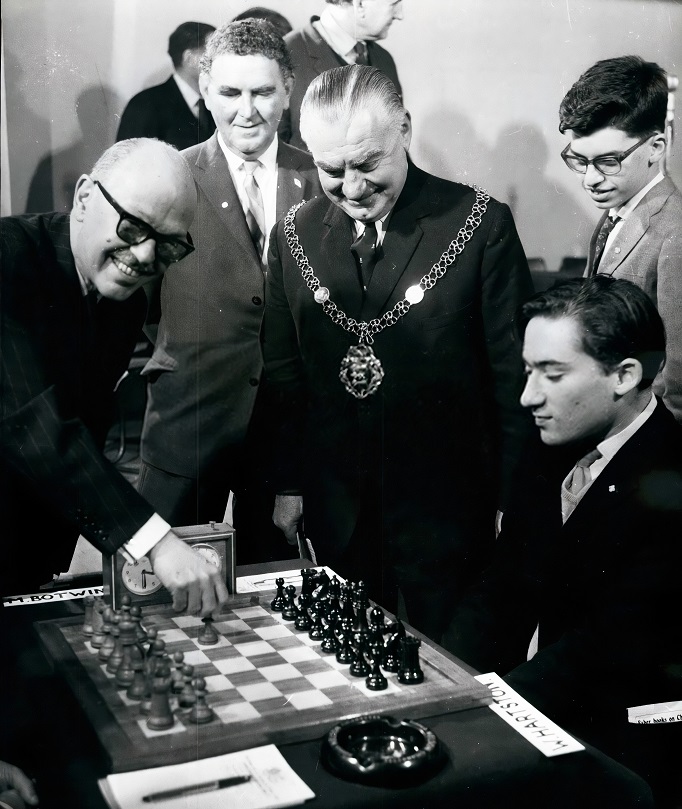
Also Hastings, 1966, with, among others Frank Rhoden and Henrique Mecking (Keystone Archive)
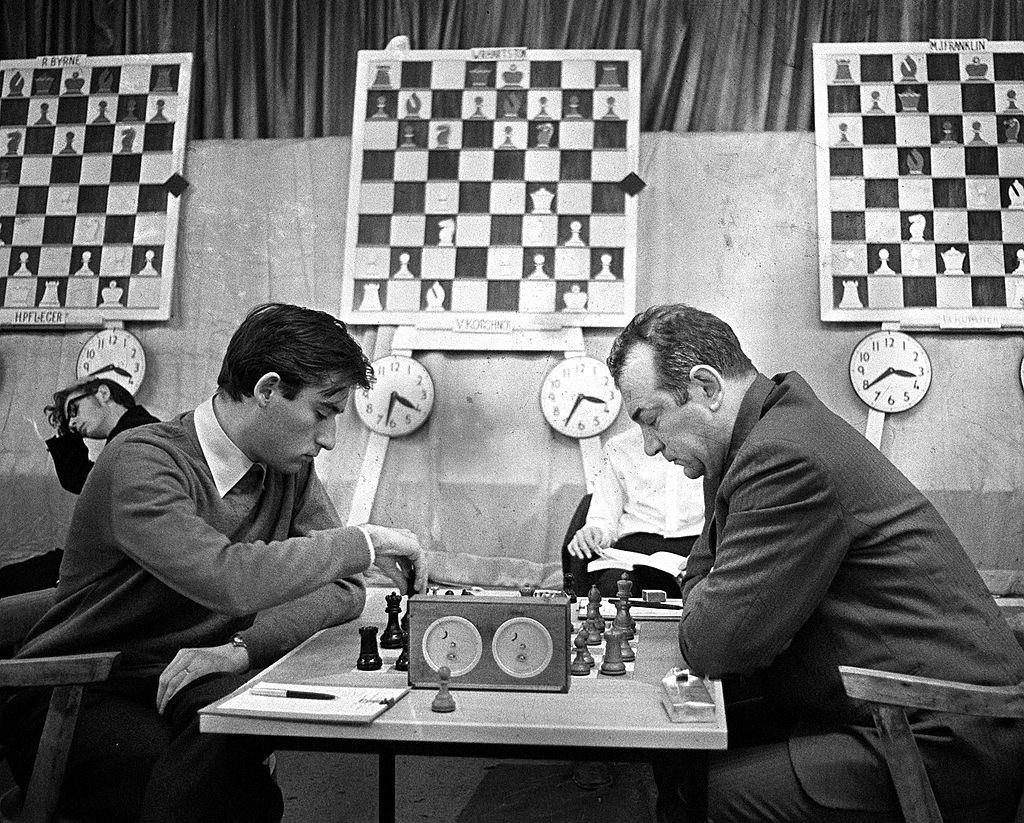
Against Victor Korchnoi, Hastings, January 1972, (Popperfoto Archive)
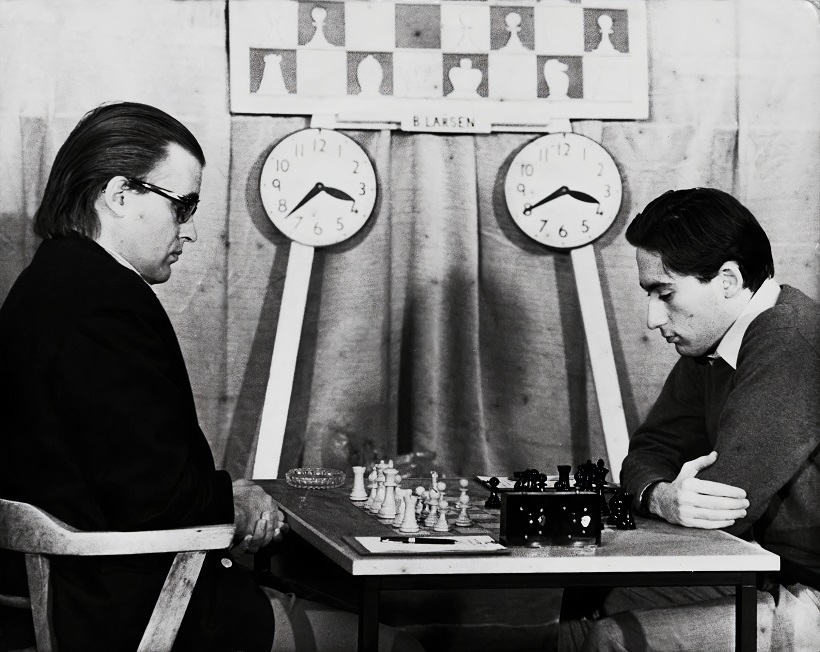
Against Bent Larsen, Hastings, January 1973 (Hulton Archive)

February 1973 (Hulton Archive)

Against Boris Spassky, European Team Championship, Bath, July 1973 (Hulton Archive)
William Hartston informs us that he considers his best work to be Sloths! (London, 2018), later issued in a paperback edition with no exclamation mark in the title.
(11872)
Addition on 3 February 2023:
We are grateful to Olimpiu G. Urcan for permission to reproduce two further photographs of Hartston, from the Archive of the Daily Telegraph:
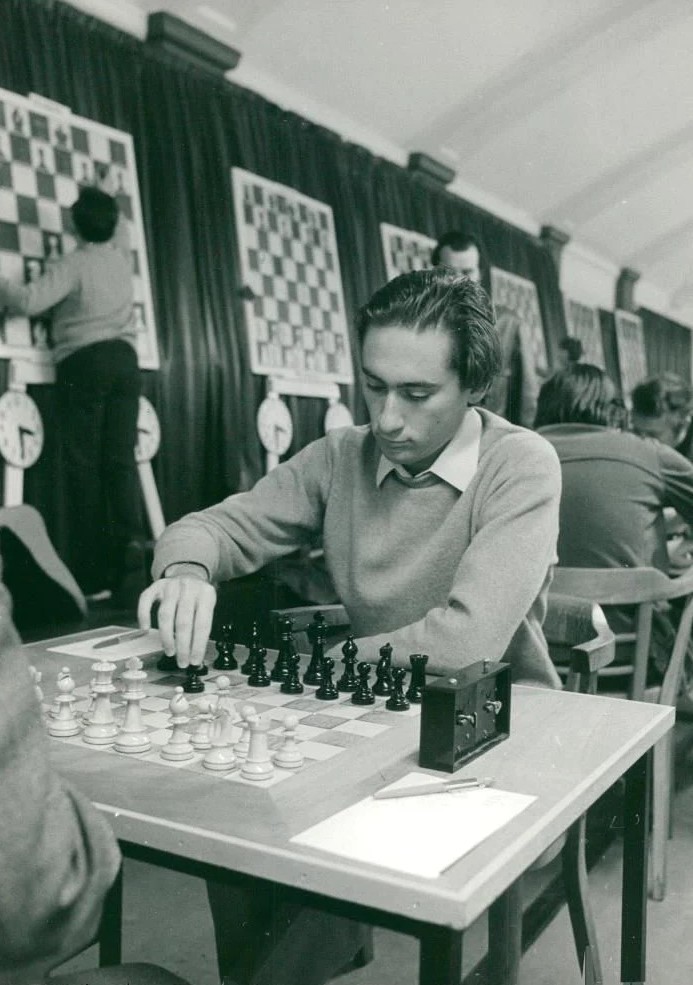

To the Chess Notes main page.
To the Archives for other feature articles.
Copyright: Edward Winter. All rights reserved.